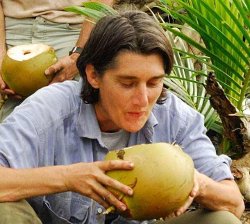
Marie-Pierre Ledru
(ISEM, France)

BIO
Marie-Pierre Ledru is a palynologist working at IRD (Institut de Recherche pour le Développement) since 1994. Her main research areas are tropical forest dynamics in relation to Quaternary climatic changes and human impact. She is a graduate in Cell Biology and Quaternary Geology of the University of Paris VI and Museum National d'Histoire Naturelle of Paris. She was a visiting professor at the University of São Paulo (USP), in the Geosciences Dpt from 1998 to 2003, and at the Universidade Centrale del Ecuador (UCE) in the Botany Dpt (2007-2009). She is now based at the Institut des Sciences de l'Evolution at Montpellier. She is currently developing projects in the high Andes of Bolivia and Ecuador, in the rainforest refugia of Northeastern Brazil, and in islands of the Indian Ocean (Seychelles and Madagascar).
ABSTRACT
Responses of the tropical forest to stressful situations: past for future
Marie-Pierre Ledru IRD Institut des Sciences de l'Evolution-Montpellier France
The Quaternary, the past 2.6 million years, is characterized by changes in Earth's orbital geometry or orbital cycles, twenty ice age cycles, and significant reorganizations in ocean-atmosphere couplings at decadal to millenial time scales. All these events induced specific responses of the biomes, potentially influenced speciation and accounted for diversification. In function of the forcing agents involved, several types of responses can be distinguished, ecological succession, migration, community stability, niche conservatism, extinction, etc.
In the tropics, the nature of the climate changes displayed specific combination of climatic variables linked to species life history. Improving our knowledge in this field requires the integration of multiple approaches and perspectives. Results of recent climate and vegetation model predictions, plant fossil information, and genetic analyses will be examined to link past climate changes to their associated responses from tropical fauna and flora. We will present a revision of some of the most significant climate trends and shifts of the Quaternary and the associated plant responses using the pollen records.We will show how changes in ice volume and insolation influence the activity of the different monsoons at decadal, millennial and orbital scales, infer on rainfall distribution and induce significant patterns of forest movement. Our review questions the timescale and pace of diversification, the role of large and small refugial areas in forest dynamics and how species-level tolerances to climate change determined the patterns of range expansion and retraction. Different case studies will be analysed from South American, African, Australian rainforests but also small island patterns of changes with a focus on the impact on the evolution of the tropical biodiversity. Insights into the recent human impact will be compared to the past climatic change effects on the dynamism of the forest.
(ISEM, France)

BIO
Marie-Pierre Ledru is a palynologist working at IRD (Institut de Recherche pour le Développement) since 1994. Her main research areas are tropical forest dynamics in relation to Quaternary climatic changes and human impact. She is a graduate in Cell Biology and Quaternary Geology of the University of Paris VI and Museum National d'Histoire Naturelle of Paris. She was a visiting professor at the University of São Paulo (USP), in the Geosciences Dpt from 1998 to 2003, and at the Universidade Centrale del Ecuador (UCE) in the Botany Dpt (2007-2009). She is now based at the Institut des Sciences de l'Evolution at Montpellier. She is currently developing projects in the high Andes of Bolivia and Ecuador, in the rainforest refugia of Northeastern Brazil, and in islands of the Indian Ocean (Seychelles and Madagascar).
ABSTRACT
Responses of the tropical forest to stressful situations: past for future
Marie-Pierre Ledru IRD Institut des Sciences de l'Evolution-Montpellier France
The Quaternary, the past 2.6 million years, is characterized by changes in Earth's orbital geometry or orbital cycles, twenty ice age cycles, and significant reorganizations in ocean-atmosphere couplings at decadal to millenial time scales. All these events induced specific responses of the biomes, potentially influenced speciation and accounted for diversification. In function of the forcing agents involved, several types of responses can be distinguished, ecological succession, migration, community stability, niche conservatism, extinction, etc.
In the tropics, the nature of the climate changes displayed specific combination of climatic variables linked to species life history. Improving our knowledge in this field requires the integration of multiple approaches and perspectives. Results of recent climate and vegetation model predictions, plant fossil information, and genetic analyses will be examined to link past climate changes to their associated responses from tropical fauna and flora. We will present a revision of some of the most significant climate trends and shifts of the Quaternary and the associated plant responses using the pollen records.We will show how changes in ice volume and insolation influence the activity of the different monsoons at decadal, millennial and orbital scales, infer on rainfall distribution and induce significant patterns of forest movement. Our review questions the timescale and pace of diversification, the role of large and small refugial areas in forest dynamics and how species-level tolerances to climate change determined the patterns of range expansion and retraction. Different case studies will be analysed from South American, African, Australian rainforests but also small island patterns of changes with a focus on the impact on the evolution of the tropical biodiversity. Insights into the recent human impact will be compared to the past climatic change effects on the dynamism of the forest.
